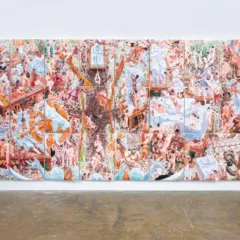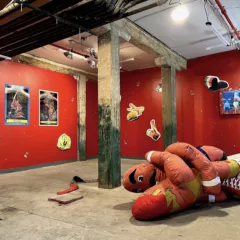—Rachel’s review asks the important question, must every piece in an exhibition be great? Read on to find out how she answers her own question.–The artblog editors————————
The first piece stole the show. McDonalds’ French fry containers shaped into diamonds in a grid projecting from a white wall, row after column of that signature red popping forth with those golden arches adding the glistening touch. In fact, before diamonds I saw spinning tops – an endless army with the concepts of repetition, colonization, mass-consumption, and iconographic invasion playing out on the wall’s surface. The shadows produced from the individual pieces create layer upon layer of conviction, providing both an aesthetically striking experience and a realization of corporate systematization.
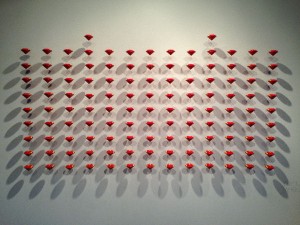
Ken Derengowski’s piece “Manufactured” is splendid. An art history professor once said that the golden arches are one of the top five most recognizable icons in the world, alongside the cross and the Star of David. Whether this statement is statistically true is irrelevant – we all know McDonald’s global recognition is extensive and exhaustive. With smartness and whimsy, Derengowski subtly reminds us of this global corporate saturation that continues to impinge on the world’s public space, imaginations and bodies.
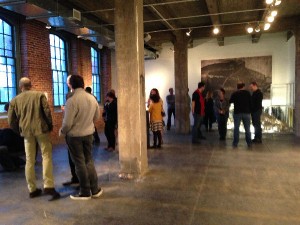
As a whole, “Systemic Devotion” is an exhibition about materiality.
Each artist brings a knowledge and craft pertaining to individual artistic genres, including oil painting, sculpture, and mixed media. For instance, Derengowski identifies as a metal-smith, directly playing with that identification through the cardboard fabrication of diamonds. Beyond the materials, “Systemic Devotion” also directly engages the social, with many of the pieces intertwined in the complexities and nuances of the exhibition’s title.
Curators Candace Karch (formerly of Bambi Art Gallery) and John Margraff II explain the exhibition as “defining how six artists communicate method, placement and discipline in the world.”
Must every piece in an exhibition be great?
A dialogue is certainly taking place among the pieces in Gallery 102, balanced in such a way that invites viewers to connect the dots among the various textures spotting the room. How successful some works are individually, however, remains to be decided, leaving me with the question: Must every piece in an exhibition be great?
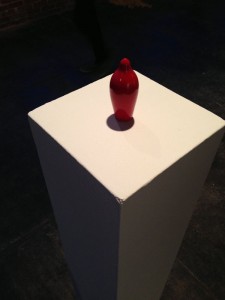
Chris Collins’ works add slyness to the exhibit. In his individual works: “Colony (Elephant Condoms),” “Red Cast Condom,” and “Bronze and Aluminum Cast Condoms,” Collins plays with the simplicity of modernist forms with that perfect dab of tongue-in-cheek. The pieces have a seemingly universal shape that allow the viewer’s imagination to wander through natural and architectural references– before reading the title sheet and grinning in the realization that the works actually represent condoms. Indeed, the pieces play with concepts of advertising, layering, and invisibility without saying a word, so cleverly brilliant they are almost too good.
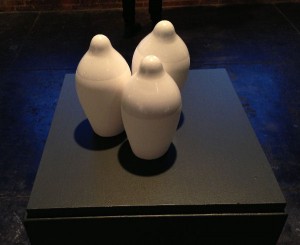
Collins also collaborated with artist Jennifer Joseph in “Bullet Halo 1, 2, 3” and “The Rapture Project: Version Two.” Showing three shooting range target sheets with bullet holes painted in 23K gold leaf, the successful pairing of minimalism’s simplistic beauty and complex critique is outstanding. Each sheet presents its own pattern of gold-spotted terror – hanging quietly yet infused with the memory of its making. And on the floor below the sheets are 1000 lead bullets also gilded with 23K gold leaf, remnants of a systemic devotion that is ever more relevant today.
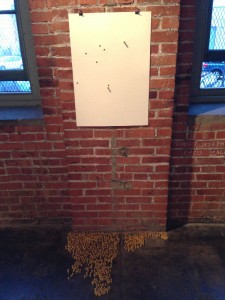
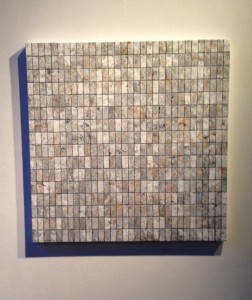
The calm in the show comes from Diane McGregor’s oil on canvas works. Described as “an exercise in a repetition of the grid, these process-driven abstractions reference patterns of order and randomness in nature.” Indeed, the works all seem to emit a wintery snow-scene or foggy afternoon layered under a rigid black-lined grid. The canvases break up the concept-driven pieces in the room and add that necessary component of square flatness that refocuses the viewer. They are good for the show but bring nothing new about grids or the concept of systems to the table.
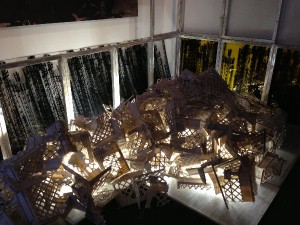
The largest work in the space is Joseph Leroux’s site-specific installation “In The Pines.” Destroyed milk crates are piled on top of a light box placed on the floor. Images of jet-black construction cranes and pulleys loom from behind, and a large, dark print of a destroyed school bus hangs above. The connotations of conflict, environmental destruction, structural collapse, and urban grit are evident, as Leroux plays with materiality through textures, assemblage, and light. The piece feels like a junkyard or construction site rendered in miniature. Yet knowing that the artist’s intention is to make a bold statement, I am unfortunately left wondering what it is.
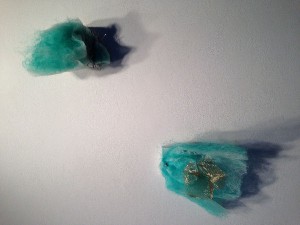
Madelin Coit’s six “Meshworks” combine mesh, chicken wire, and insulation in lit sculptural forms. Because I am rarely drawn to these sorts of mixed media pieces, my enthusiasm is not particularly high. The pieces are certainly dramatic, well edited, and pretty, adding a level of texture to the room that makes one reconsider material nuance. But what more the pieces speak to seems unanswered.
Systemic Devotion succeeds in delivering a well-balanced interplay between works and their materials, and I would return just to get lost in Derengowki’s piece or chuckle at Collins’ wit.
Overall, the show has a narrative quality, showcasing some phenomenal works that speak to consumption, mass marketing, value systems, and conflict. All of the works play with repetition and shadows, with the artists’ uses of well-executed materials, and the artists are clearly grounded in their respective crafts. While some individual works are uninspiring or not fully developed, as a whole, the show will leave you thinking and questioning – and that is always most important.
Systemic Devotion is on view at Crane Arts’ Gallery 102 through April 27th.


